Experimental Report 4:
Mapping the Energy Body
by Heliognosis
The idea that an energy body surrounds the human form has endured since
ancient times. The Tibetan Book of the Dead1 refers
to it in a ritualistic speech made to the dying to prepare them for the
states they are about to encounter. Carlos Castaneda discusses it at
great length in his famous apprenticeship to become a warrior and to
sidestep the destruction of his awareness at the moment of death2. Wilhelm Reich described an energy
he called Orgone,
which pervaded everything and was concentrated in living organisms3.
Despite having been described by many cultures and researchers an
objective method to observe the energy body has remained elusive.
Energy Body Theories
The
Chakra system of interpretation identifies the primary energy
concentrations in the body. These are defined as the crown of the head,
the third eye at the center of the forehead, the throat, the heart
(comprised of a center, left and right side), the solar plexus, the
navel and the genitalia or root 4.
This system originated in Asia and is not perceived directly by the
practitioner. In contrast, Carlos
Castaneda claimed that he was taught to actually see the energy body by
following the practices carried down from the Toltecs. Castaneda
depicted the energy body as being shaped like an oblong egg encased in
a cocoon that stretches seven feet above the ground and four feet wide5.
According to his descriptions, the energy body could potentially escape
through the crown during moments of intense stress. The head was
considered to be the center of reason and talking. The tip of the sternum was the center of
feeling. The center below the naval was the will,
and the genital and anal region were final energy concentrations in the
lower body. In addition, the left side of the ribs was considered the
center for seeing and the
right side the center for dreaming6.
Castaneda mentions a total of eight energy centers as opposed the nine
within the Chakra system. As well, Castaneda stresses that the energy
center of the body is also the geometric center of the body. Another
feature of the energy body unique to Castaneda is the presence of an assemblage point where
awareness is manifest, located on the back over the right shoulder blade7.
To
contrast Reichian energetic theory, the proper flow of energy is from
the core to the periphery and back to the core cyclically. The
pulsation of the body Orgone is associated with deep breathing and
oxygenation of the tissues as well as orgastic charge and discharge.
The primary energy centers for a Reichian energy perspective is the
solar plexus and the heart/lungs for breathing and the genitals for
orgastic potency8.
These three regions together form the core with the center around the
solar plexus area.
Instrumentation
 Techniques
such as Kirlian
photography have
been used to visualize the portion of the energy body which emanates
from the fingertips or hands. This technique has been used to evaluate
the overall health of the person by analyzing the strength and quality
of the electric field patterns around the fingers. Although Kirlian
photography will remain a valuable technique, it remains limited to
indirect measurement of the quality and shape of the energy body. Techniques
such as Kirlian
photography have
been used to visualize the portion of the energy body which emanates
from the fingertips or hands. This technique has been used to evaluate
the overall health of the person by analyzing the strength and quality
of the electric field patterns around the fingers. Although Kirlian
photography will remain a valuable technique, it remains limited to
indirect measurement of the quality and shape of the energy body.
The
Orgone Field Meter of Wilhelm Reich employed a similar sensing field to
the Kirlian method. Using an optically coupled galvanometer, Reich was
able to sense the decline of vitality in plants and fish as a function
of time after death. His device however was limited to the observation
of the overall energy and was not able to provide an energetic map for
the body. The Orgone Field Meter principle and the Kirlian principle
are both based on the ability of living tissue to differentially absorb
and radiate electric displacement currents. This same principle has
been improved upon and has been built into a scanning system that can
detect the energy body up to a distance of 60cm. By employing this
scanning method, a profile of the energy body may be created from head
to toe. A picture of the scanning apparatus is shown at the left.
The
scanner is composed of a plastic tubular frame with a low speed motor
drive. The motor allows the Experimental Life Energy Meter to descend
or ascend at a fixed speed of 1ft/sec. The sensitivity of the meter is
selected so that the subject will be 6 inches to 1 foot away from the
tube sensor. The optimum range is x100 and the zero is set to zero when
there is no subject present and the meter is midway through its travel.
Switches at the top and bottom of the frame stop the meter travel as it
arrives. Because these switches are connected inductively to ground,
the meter reading increases quickly as it approaches them. In order to
avoid such effects, all extraneous objects should be kept at least 18
inches away from the scanner during the procedure.
The
subject stands facing the scanning frame and the operator activates the
Life Meter to descend. The data is collected by a data acquisition
system and plotted graphically on the computer display. The image is
then saved into an image-processing program. The subject then stands
facing away from the scanner while the operator scans the energy
profile from behind. These two images are then composed with a picture
of the subject on the computer to form the complete energy profile.
Typical
Male and Female Scans
In
figure 1a a 32 year old healthy male exhibits a typical energy pattern.
To the left of the male figure is a graph of the data collected from
the rear of the body. To the right is the plot of the energy from the
front of the body. The graphs are coloured to show the regions of
interest. Each graph has a scale for the energy intensity from zero to
eight. These areas are coloured in the following way:
- Purple: Crown of the head and the region immediately
above the head
- Sky blue: Eyes
- Dark blue: Throat and upper shoulders
- Green: Heart
- Yellow: Solar plexus
- Orange: Naval
- Red: Genitals or root
Figure 1a
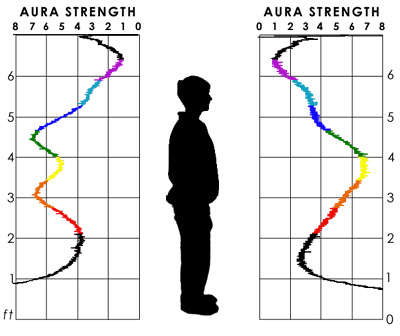 |
Figure 1b
 |
This
subject is a healthy young adult male that will be used to compare the
relative strengths and weaknesses of the energy pattern of other male
subjects. This will be done by comparing the intensity of the energy at
each level as well as its direction, forward or behind. The coloured
bar graph in figure 1b shows the combined average of the front and rear
readings at each of the above levels. Again the maximum reading is
eight.
Referring
now to figure 1a, we can see that the energy begins to expand starting
6 inches above the head. A local peak in the energy field is then
observed at the level of the eyes. Around the throat, the energy field
begins to expand gradually into the heart region. This peak is most
noticeable at the rear of the body. The energy field then pushes
forward to a peak at the front of the body at the solar plexus region
while drawing in slightly at the rear. The energy field then reaches a
second major peak at the rear of the body at the pelvis. At the front
the energy field begins to close in on itself gradually below the solar
plexus. The field then draws inward around the genitalia reaching a
minimum around knee level. Below 1.5 feet from the ground, the
influence of the earth causes a sudden increase in the energy reading.
Looking at the average energy of each level we can see that the heart
has the strongest emanation followed by the naval and solar plexus.
Figure 2a
 |
Figure 2b
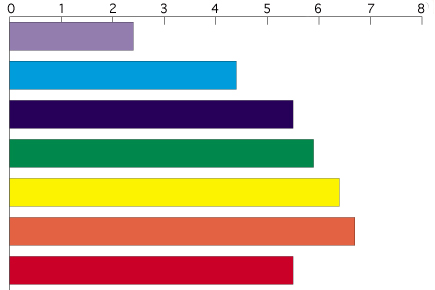 |
A
healthy female, 29 years old, is shown in figure 2a. Looking at the
energy body from the front, her field begins to expand 12 inches above
the head. A noticeable peak can be observed at eye level. The throat
region shows a gradual increase with a peak at the base of the neck as
seen from the rear, roughly corresponding to the "assemblage point"
described by Carlos Castaneda. The female field expands forward at the
heart while the energy is drawn in slightly at the rear. Forward
expansion continues peaking at the solar plexus while, at the rear, the
energy peaks at the naval. The energy body then draws inward around the
genitalia and reaches a minimum in the mid thigh. From the average
energy data, we can see that the female has her highest energy level at
the naval followed by the solar plexus and heart. All of the following
female subjects will use her scan as a reference for comparison.
The
male energy above the head has an average value of 1.8 compared to 2.4
for the female. The female energy above the head is also visible 6"
higher than the male. The female energy is also greater at the eye
level at 4.4 compared to the male at 3.2. The same trend continues at
the throat with the female at 5.5 contrasted with the male average
reading at 4.6. This trend begins to reverse at the heart where the
average male reading peaks at 6.3 vs 5.9 for the female. The female
again averages higher at the solar plexus at 6.4 vs 6 for the male. At
the naval, the female has the highest average at 6.7 vs 6.1 for the
male. Around the genitalia, the female is 5.5 vs 4.5 for the male.
Around the legs where the energy is lowest, the female is 4.8 and the
male is 3.4.
From
the above numerical analysis, it can be seen that the male energy is on
average strongest at the heart. The energy is evenly distributed around
the solar plexus and is located at the centre of gravity for the adult
male. The male exhibits two major peaks at the heart and naval regions.
Looking only at the front energy, the peaks are at the eyes and solar
plexus. From the rear, the peaks are at the eyes, heart and naval.
For
the female, the strongest average energy is at the naval level. The
naval is the only average peak for the female. This also corresponds
with the natural centre of gravity for an adult female. From the front,
the female exhibits peaks at the eyes, heart and solar plexus. From the
rear, the peaks are at the heart and naval.
From
a Reichian perspective, the core of the organism would contain the
greatest amount of Orgone energy. For the typical male, the energy is
concentrated in the heart and lungs in contrast to the female, whose
energy is strongest in the diaphragm and womb areas. The main forward
energy peak of both male and female corresponds to the physical center
of the body in agreement with Castaneda's assertion as well as the
conception that we are connected to the world by an invisible thread of
energy emanating from our solar plexus region. It is possible that the
energy peak that everyone exhibits around the shoulder blade area may
correspond to the "assemblage point". Men's enhanced heart area would
indicate that they have a natural affinity for feeling, seeing and
dreaming. The naval peak in the female energy body may be due to a
concentration of energy in the womb. The aura around the body is
affected by various lifestyle, health, vitality and psychological
conditions and the scans may be used to help identify these conditions.
Subjects
for Comparison
The
average data for each male subject was subtracted from the average data
of the typical male of figure 1 to yield a second bar graph to the far
right in addition to the Aura strength scans (left) and the average
energy data (center). This final bar graph shows how the energy at each
level for the subject is either greater or less than the typical
healthy male.
Figure 3a
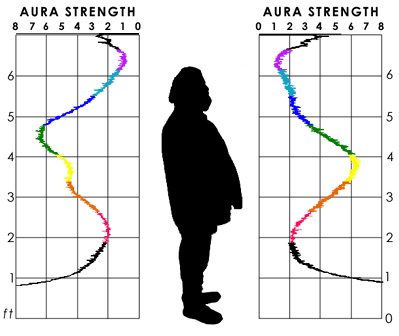 |
Figure 3b
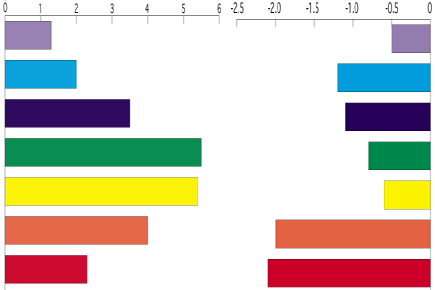 |
In
figure 3a a portly male subject is shown. The average energy data
indicates an overall low energy for this subject by 20%. Energy is
particularly subdued above the heart and below the solar plexus.
Specifically, there is a particularly strong reduction in the energy of
the naval and genital regions.
Figure 4a
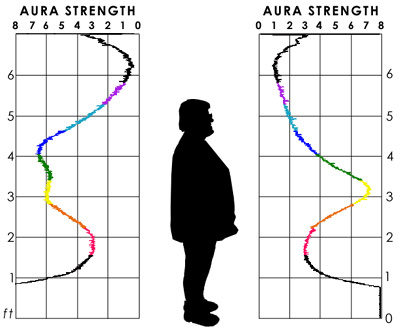 |
Figure 4b
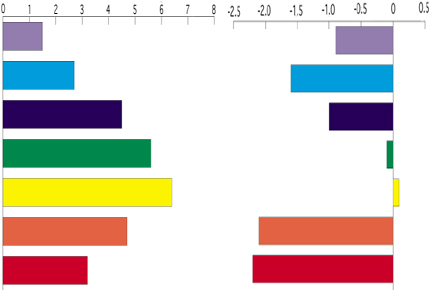 |
Figure
4a shows a portly female subject. Her average data is subtracted from
the average data of the typical female in figure 2a and displayed in
the bar graph figure 4b. As with the portly male, the average energy
data indicates a generally reduced energy of about 15%. The naval and
genital regions are close to normal but the throat and head regions are
weak. From the front and rear energy chart, the forward energy can be
seen to be concentrated exclusively at the solar plexus.
Figure 5a
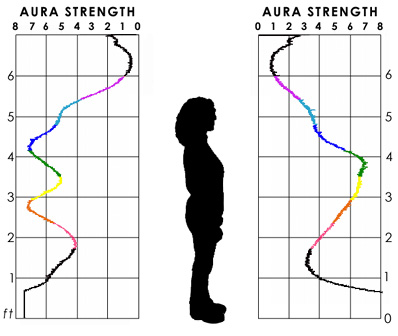 |
Figure 5b
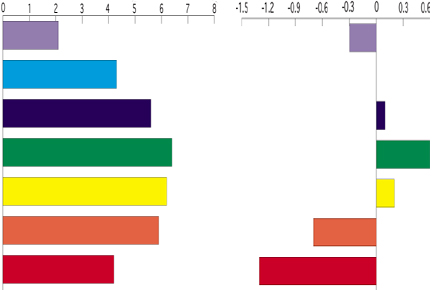 |
Figure
5a is a 37-year-old mother of two. Her overall health is good but she
has a minor digestive and growth disorder. Comparing her to the typical
female, her average energy pattern is virtually the same above the
heart. Her heart energy though is stronger than normal by 10%. This is
also evident from the heart peak from her frontal energy scan. She has
a reduction in energy at the genital area of 15%. In this particular
case, the overall energy is normal and strong. The elevation of energy
from the lower part of the body towards the heart may be due to a
highly relaxed state. Evidence for this will be illustrated in figure
13a.
Figure 6a
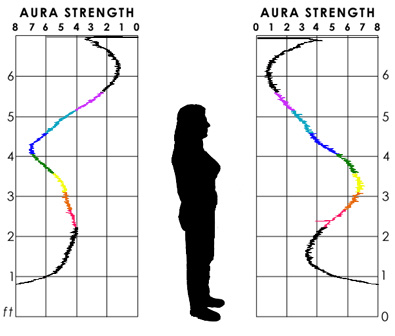 |
Figure 6b
 |
Figure
6a shows a second, 45 yr old, mother of two who has suffered from a
digestive ailment but is otherwise healthy. Her average energy pattern
is almost identical to the previous woman and exhibits a slight
reduction below the heart. Organ damage in the solar plexus and naval
region may be responsible for the 15% reduction in energy in that
region. It is interesting to note that the reduction in energy in the
lower part of the body is almost exclusively at the rear.
Figure 6a
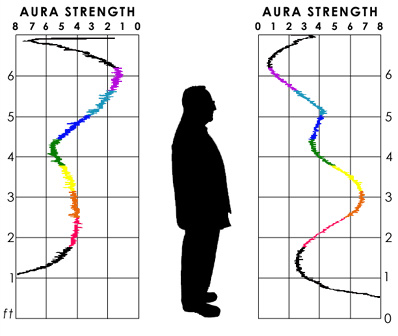 |
Figure 7b
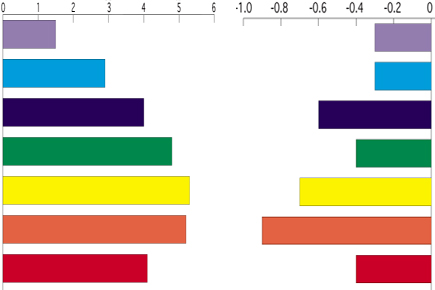 |
Old
age does not dramatically effect the aura if the health is good. As can
be seen in the male of figure 7a, the energy around the heart is
projected predominantly backward and the root energy is drawn towards
the front of the body. Head and solar plexus energy remains normal.
From the average data, it is clear that there has been a significant
reduction in the heart energy with the maximal peak now for the solar
plexus/naval regions. From the front energy profile, it is apparent
that the overall energy of the body has shifted downward towards the
naval. There is about a 10% reduction in overall energy.
Figure 8a
 |
Figure 8b
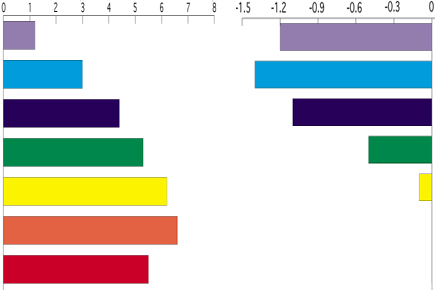 |
In
figure 8a is shown an elderly female subject. The average energy
profile is very similar to the typical female except for a 20%
reduction in the above head and eye energy levels. The front profile
also confirms that the energy body has become more concentrated around
the solar plexus and naval region. At the rear of the body, the energy
at the solar plexus level is almost equal to that of the heart and
naval areas.
Figure 9a
 |
Figure 9b
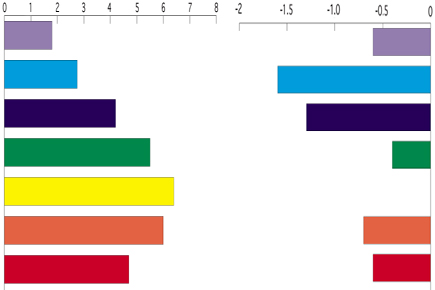 |
In
figure 9a is the energy profile of a spiritual healer. It is
interesting to note that her frontal energy is concentrated in the
solar plexus area exclusively. This in confirmed by both the average
data as well as the front scan data. This would be in agreement with
the shamanic will emanations from this region for healing.
Figure 10a
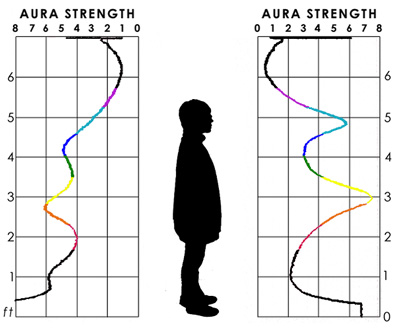 |
Figure 10b
 |
Figure
10a shows a woman who is under great psychological stress. Her centres
of reason (head) are over stimulated and emanating with a particularly
strong projection. Her heart and throat energy have been borrowed for
this task. Her solar plexus energy resembles that of a healer, being
focused intensely. Her entire energy field is compressed overall by
about 20%. It is likely that this energy compression is a form of
spiritual defense.
Figure 11a
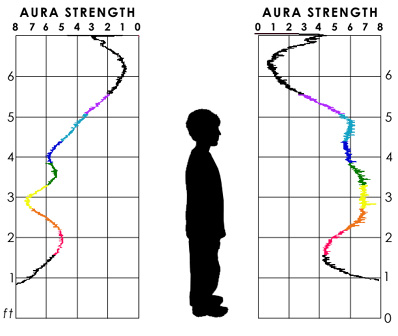 |
Figure 11b
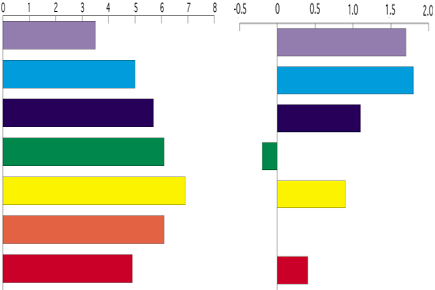 |
In
figure 11a is shown an 11-year-old boy. His weight and health are
normal but his personality is dominated by sports and aggressive
behavior. The aggressive child has a diffuse frontal energy shape
almost uniformly projecting from head to root. Overall his energy is
very strong, 10-15% higher than normal, especially from the head. It is
interesting to note that children, with a smaller frame than adults,
yield a more intense energy profile.
Figure 12a
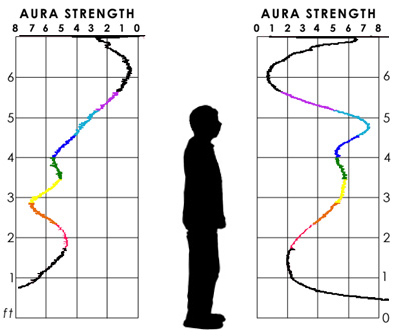 |
Figure 12b
 |
In
figure 12a, another 11-year-old boy is shown who avoids physical
activity and invests his energy predominantly on computer and video
games. The virtual child
has an enhanced eye energy with an intense projection of reason and
intellectualization of almost 30%. There is a corresponding reduction
in the heart, naval and genitals. The overall energy of his body is
normal.
Figure 13a
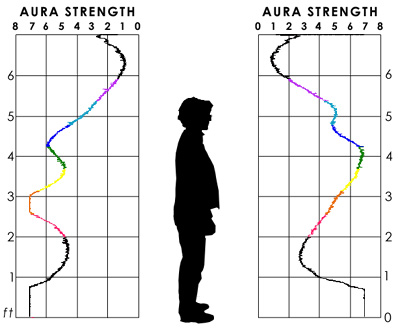 |
Figure 13b
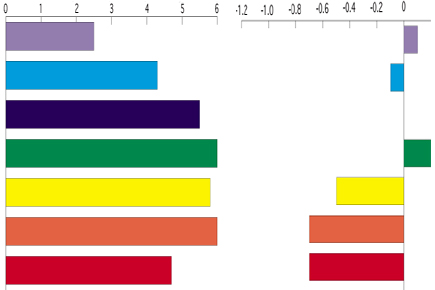 |
In
figure 13a, a woman is shown who had just received a Shiatsu massage.
It is interesting to note that her energy from the solar plexus has
been elevated and that her predominant forward energy band is from the
heart emphasizing her feeling and dreaming centre. This is confirmed by
the average data that shows the heart region has increased at the
expense of the solar plexus, naval and genital regions. Her overall
energy is normal.
Figure 14a
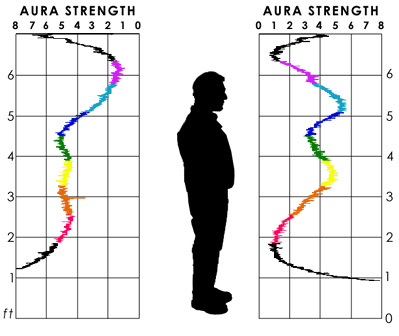 |
Figure 14b
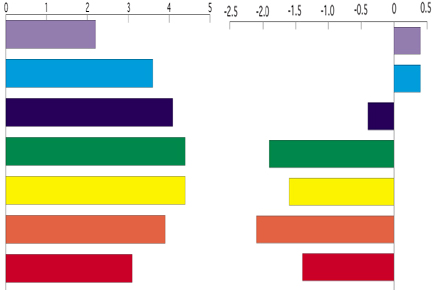 |
Figure
14a shows an adult male subject who has a predominant emanation from
the head. It is also fascinating that this subject also shows a
distinct forward emanation from the crown unlike most subjects. The
average energy data also reveals an unusually high energy from the head
region. This gentleman is active in environmental issues and exhibits a
burning curiosity.
Summary
For
a healthy male, the solar plexus region has the highest concentration
of energy. For the healthy female, the naval is the strongest level.
For overweight subjects, the overall energy of the body is reduced by
15 - 20% especially above and below the body centre. Elderly subjects
show a 10-20% reduction in overall energy where as children exhibit an
increase of 10-30%. Psychological stress or overemphasis on
intellectualization tends to focus the forward energy of the body at
the eyes and solar plexus. Relaxation tends to draw the energy from the
lower body to the heart region.
In
addition to these general factors of health, specific conditions such
as organ damage, stress, childbearing, aggressive behavior and other
physical and mental conditions influence the distribution and strength
of the energy in the body.
References
1 Tibetan
Book of the Dead, Instructions
on the six yogas of Naropa
2 Journey
to Ixtlan, Carlos
Castaneda, page 139
3 The
Cancer Biopathy, Wilhelm
Reich, page 96
4 The
Tree of Life Within All Humans
5 The
Eagles Gift, Carlos
Castaneda, page 46
6 Tales
of Power, Carlos
Castaneda, page 96
7 The
Eagles Gift, Carlos
Castaneda, page 168
8 The
Function of The Orgasm, Wilhelm
Reich, pages 293 - 294 |
 Techniques
such as Kirlian
photography have
been used to visualize the portion of the energy body which emanates
from the fingertips or hands. This technique has been used to evaluate
the overall health of the person by analyzing the strength and quality
of the electric field patterns around the fingers. Although Kirlian
photography will remain a valuable technique, it remains limited to
indirect measurement of the quality and shape of the energy body.
Techniques
such as Kirlian
photography have
been used to visualize the portion of the energy body which emanates
from the fingertips or hands. This technique has been used to evaluate
the overall health of the person by analyzing the strength and quality
of the electric field patterns around the fingers. Although Kirlian
photography will remain a valuable technique, it remains limited to
indirect measurement of the quality and shape of the energy body.